Indication Variability of the Particulate Matter Sensors Dependent on Their Location
Abstract
1. Introduction
1.1. Health Impact of PM
1.2. Seasonal and Geographical Changes in PM Concentration
1.3. Methods of PM Measurement
1.4. Measurement Systems Relying on Low-Cost Sensors
1.5. Importance of Calibration
1.6. Citizen Protection
1.7. Motivation for This Work
2. Material and Methods
2.1. Place of Investigations
- 1.
- Size of the monitored area—the larger the area, the more sensors;
- 2.
- Number of smoke sources—the more sources, the more sensors;
- 3.
- Distance and direction of the smoke source from the measurement place—the farther from the smoke source, the fewer sensors;
- 4.
- Distance from buildings and other obstacles taller than a human—the closer the smoke source is, the more sensors are required;
- 5.
- Access to power and the Internet;
- 6.
- The frequency of indication readings together with processing carried out on raw data, e.g., filtration, interference compensation, influence correction of atmospheric conditions; averaging over a few-minute time window—the closer the source of smoke, the shorter the time window.
2.2. Measurement Network
2.3. Phases of Experiments
3. Results and Discussion
3.1. Effect of Location on PM Measurements
3.1.1. Initial Tests of the Measurement Network
3.1.2. PM Measurements at One Location
3.1.3. PM Measurements in Various Locations
Differences in Indications over Time
- Sensor accuracy—0.010;
- PM heterogeneity around the post—0.010;
- PM heterogeneity over the plot—0.022.
Analysis of Specific Moments
3.2. Recognition of Smoke in the Air
4. Conclusions
Author Contributions
Funding
Institutional Review Board Statement
Informed Consent Statement
Data Availability Statement
Conflicts of Interest
References
- WHO. WHO Global Air Quality Guidelines: Particulate Matter (PM2.5 and PM10), Ozone, Nitrogen Dioxide, Sulfur Dioxide and Carbon Monoxide; World Health Organization: Geneva, Switzerland, 2021. [Google Scholar]
- Chlebowska-Styś, A.; Sówka, I.; Kobus, D.; Pachurka, Ł. Analysis of concentrations trends and origins of PM10 in selected European cities. E3S Web Conf. 2017, 17, 00013. [Google Scholar] [CrossRef]
- Koçak, M.; Mihalopoulos, N.; Kubilay, N. Contributions of natural sources to high PM10 and PM2.5 events in the eastern Mediterranean. Atmos. Environ. 2007, 41, 3806–3818. [Google Scholar] [CrossRef]
- Wielgosiński, G.; Czerwińska, J. Smog Episodes in Poland. Atmosphere 2020, 11, 277. [Google Scholar] [CrossRef]
- Shin, D.; Kim, Y.; Hong, K.J.; Lee, G.; Park, I.; Kim, H.J.; Kim, Y.J.; Han, B.; Hwang, J. Measurement and Analysis of PM10 and PM2.5 from Chimneys of Coal-fired Power Plants Using a Light Scattering Method. Aerosol Air Qual. Res. 2022, 22, 210378. [Google Scholar] [CrossRef]
- Vega, E.; López-Veneroni, D.; Ramírez, O.; Chow, J.C.; Watson, J.G. Particle-Bound PAHs and Chemical Composition, Sources and Health Risk of PM2.5 in a Highly Industrialized Area. Aerosol Air Qual. Res. 2021, 21, 210047. [Google Scholar] [CrossRef]
- Pastuszka, J.S.; Rogula-Kozłowska, W.; Zajusz-Zubek, E. Characterization of PM10 and PM2.5 and associated heavy metals at the crossroads and urban background site in Zabrze, Upper Silesia, Poland, during the smog episodes. Environ. Monit. Assess. 2009, 168, 613–627. [Google Scholar] [CrossRef] [PubMed]
- Querol, X.; Alastuey, A.; Ruiz, C.; Artiñano, B.; Hansson, H.; Harrison, R.; Buringh, E.; ten Brink, H.; Lutz, M.; Bruckmann, P.; et al. Speciation and origin of PM10 and PM2.5 in selected European cities. Atmos. Environ. 2004, 38, 6547–6555. [Google Scholar] [CrossRef]
- Fitz, D.R.; Bumiller, K.; Etyemezian, V.; Kuhns, H.D.; Gillies, J.A.; Nikolich, G.; James, D.E.; Langston, R.; Merle, R.S. Real-time PM10 emission rates from paved roads by measurement of concentrations in the vehicle’s wake using on-board sensors Part 2. Comparison of SCAMPER, TRAKER™, flux measurements, and AP-42 silt sampling under controlled conditions. Atmos. Environ. 2021, 256, 118453. [Google Scholar] [CrossRef]
- Kholodov, A.; Kirichenko, K.; Vakhniuk, I.; Fatkulin, A.; Tretyakova, M.; Alekseiko, L.; Petukhov, V.; Golokhvast, K. Measurement of PM2.5 and PM10 Concentrations in Nakhodka City with a Network of Automatic Monitoring Stations. Aerosol Air Qual. Res. 2022, 22, 220040. [Google Scholar] [CrossRef]
- Witkowska, A.; Lewandowska, A.U.; Saniewska, D.; Falkowska, L.M. Effect of agriculture and vegetation on carbonaceous aerosol concentrations (PM2.5 and PM10) in Puszcza Borecka National Nature Reserve (Poland). Air Qual. Atmos. Health 2015, 9, 761–773. [Google Scholar] [CrossRef] [PubMed]
- Zalakeviciute, R.; Rybarczyk, Y.; Granda-Albuja, M.G.; Suarez, M.V.D.; Alexandrino, K. Chemical characterization of urban PM10 in the Tropical Andes. Atmos. Pollut. Res. 2020, 11, 343–356. [Google Scholar] [CrossRef]
- Finlayson-Pitts, B.J.; Pitts, J.N., Jr. Chemistry of the Upper and Lower Atmosphere: Theory, Experiments, and Applications; Elsevier: Amsterdam, The Netherlands, 1999. [Google Scholar]
- Liu, Y.; Li, X.; Wang, W.; Yin, B.; Gao, Y.; Yang, X. Chemical Characteristics of Atmospheric PM10 and PM2.5 at a Rural Site of Lijiang City, China. Int. J. Environ. Res. Public Health 2020, 17, 9553. [Google Scholar] [CrossRef]
- Mach, T.; Rogula-Kozłowska, W.; Bralewska, K.; Majewski, G.; Rogula-Kopiec, P.; Rybak, J. Impact of Municipal, Road Traffic, and Natural Sources on PM10: The Hourly Variability at a Rural Site in Poland. Energies 2021, 14, 2654. [Google Scholar] [CrossRef]
- Borlaza, L.J.; Weber, S.; Marsal, A.; Uzu, G.; Jacob, V.; Besombes, J.L.; Chatain, M.; Conil, S.; Jaffrezo, J.L. Nine-year trends of PM10 sources and oxidative potentialin a rural background site in France. Atmos. Chem. Phys. 2022, 22, 8701–8723. [Google Scholar] [CrossRef]
- Jaafari, J.; Naddafi, K.; Yunesian, M.; Nabizadeh, R.; Hassanvand, M.S.; Ghozikali, M.G.; Shamsollahi, H.R.; Nazmara, S.; Yaghmaeian, K. Characterization, risk assessment and potential source identification of PM10 in Tehran. Microchem. J. 2020, 154, 104533. [Google Scholar] [CrossRef]
- Arif, M.; Parveen, S. Carcinogenic effects of indoor black carbon and particulate matters (PM2.5 and PM10) in rural households of India. Environ. Sci. Pollut. Res. 2020, 28, 2082–2096. [Google Scholar] [CrossRef] [PubMed]
- Widziewicz, K.; Rogula-Kozlowska, W.; Loska, K.; Kociszewska, K.; Majewski, G. Health Risk Impacts of Exposure to Airborne Metals and Benzo(a)Pyrene during Episodes of High PM10 Concentrations in Poland. Biomed. Environ. Sci. 2018, 31, 23–36. [Google Scholar] [CrossRef]
- Kwon, S.O.; Hong, S.H.; Han, Y.J.; Bak, S.H.; Kim, J.; Lee, M.K.; London, S.J.; Kim, W.J.; Kim, S.Y. Long-term exposure to PM10 and NO2 in relation to lung function and imaging phenotypes in a COPD cohort. Respir. Res. 2020, 21, 247. [Google Scholar] [CrossRef]
- Misiukiewicz-Stepien, P.; Paplinska-Goryca, M. Biological effect of PM10 on airway epithelium-focus on obstructive lung diseases. Clin. Immunol. 2021, 227, 108754. [Google Scholar] [CrossRef] [PubMed]
- Zhang, Y.; Ma, Y.; Feng, F.; Cheng, B.; Wang, H.; Shen, J.; Jiao, H. Association between PM10 and specific circulatory system diseases in China. Sci. Rep. 2021, 11, 12129. [Google Scholar] [CrossRef]
- Renzi, M.; Marchetti, S.; de’ Donato, F.; Pappagallo, M.; Scortichini, M.; Davoli, M.; Frova, L.; Michelozzi, P.; Stafoggia, M. Acute Effects of Particulate Matter on All-Cause Mortality in Urban, Rural, and Suburban Areas, Italy. Int. J. Environ. Res. Public Health 2021, 18, 12895. [Google Scholar] [CrossRef]
- Łupikasza, E.B.; Niedźwiedź, T. Relationships between Vertical Temperature Gradients and PM10 Concentrations during Selected Weather Conditions in Upper Silesia (Southern Poland). Atmosphere 2022, 13, 125. [Google Scholar] [CrossRef]
- Czernecki, B.; Półrolniczak, M.; Kolendowicz, L.; Marosz, M.; Kendzierski, S.; Pilguj, N. Influence of the atmospheric conditions on PM10 concentrations in Poznań, Poland. J. Atmos. Chem. 2016, 74, 115–139. [Google Scholar] [CrossRef]
- Kalbarczyk, R. Temporal changes in concentration of PM10 dust in Poznan, middle-west Poland as dependent on meteorological conditions. Appl. Ecol. Environ. Res. 2018, 16, 1999–2014. [Google Scholar] [CrossRef]
- Gautam, S.; Sammuel, C.; Bhardwaj, A.; Esfandabadi, Z.S.; Santosh, M.; Gautam, A.S.; Joshi, A.; Justin, A.; Wessley, G.J.J.; James, E. Vertical profiling of atmospheric air pollutants in rural India: A case study on particulate matter (PM10/PM2.5/PM1), carbon dioxide, and formaldehyde. Measurement 2021, 185, 110061. [Google Scholar] [CrossRef]
- Zuśka, Z.; Kopcińska, J.; Dacewicz, E.; Skowera, B.; Wojkowski, J.; Ziernicka–Wojtaszek, A. Application of the Principal Component Analysis (PCA) Method to Assess the Impact of Meteorological Elements on Concentrations of Particulate Matter (PM10): A Case Study of the Mountain Valley (the Sącz Basin, Poland). Sustainability 2019, 11, 6740. [Google Scholar] [CrossRef]
- Hamzah, N.; Mohd Kamil, N.A.F.; Maznan, N.S. The Measurement of PM10 and PM2.5 Concentration for Outdoor and Indoor Surrounding Industrial Area. J. Adv. Environ. Solut. Resour. Recovery 2021, 1, 9–17. [Google Scholar]
- Su, Y.; Wu, X.; Zhao, Q.; Zhou, D.; Meng, X. Interference of Urban Morphological Parameters in the Spatiotemporal Distribution of PM10 and NO2, Taking Dalian as an Example. Atmosphere 2022, 13, 907. [Google Scholar] [CrossRef]
- Danek, T.; Zaręba, M. The use of public data from low-cost sensors for the geospatial analysis of air pollution from solid fuel heating during the COVID-19 pandemic spring period in Krakow, Poland. Sensors 2021, 21, 5208. [Google Scholar] [CrossRef] [PubMed]
- Danek, T.; Weglinska, E.; Zareba, M. The influence of meteorological factors and terrain on air pollution concentration and migration: A geostatistical case study from Krakow, Poland. Sci. Rep. 2022, 12, 11050. [Google Scholar] [CrossRef] [PubMed]
- Sekuła, P.; Bokwa, A.; Bartyzel, J.; Bochenek, B.; Chmura, Ł.; Gałkowski, M.; Zimnoch, M. Measurement report: Effect of wind shear on PM10 concentration vertical structure in urban boundary layer in a complex terrain. Atmos. Chem. Phys. 2021, 21, 12113–12139. [Google Scholar] [CrossRef]
- Kim, B.M.; Teffera, S.; Zeldin, M.D. Characterization of PM25 and PM10 in the South Coast Air Basin of Southern California: Part 1—Spatial Variations. J. Air Waste Manag. Assoc. 2000, 50, 2034–2044. [Google Scholar] [CrossRef] [PubMed]
- Piwowar, A.; Dzikuć, M. Development of Renewable Energy Sources in the Context of Threats Resulting from Low-Altitude Emissions in Rural Areas in Poland: A Review. Energies 2019, 12, 3558. [Google Scholar] [CrossRef]
- Filonchyk, M.; Hurynovich, V.; Yan, H. Impact of COVID-19 lockdown on air quality in the Poland, Eastern Europe. Environ. Res. 2021, 198, 110454. [Google Scholar] [CrossRef] [PubMed]
- Karagulian, F.; Barbiere, M.; Kotsev, A.; Spinelle, L.; Gerboles, M.; Lagler, F.; Redon, N.; Crunaire, S.; Borowiak, A. Review of the Performance of Low-Cost Sensors for Air Quality Monitoring. Atmosphere 2019, 10, 506. [Google Scholar] [CrossRef]
- Cho, E.M.; Jeon, H.J.; Yoon, D.K.; Park, S.H.; Hong, H.J.; Choi, K.Y.; Cho, H.W.; Cheon, H.C.; Lee, C.M. Reliability of Low-Cost, Sensor-Based Fine Dust Measurement Devices for Monitoring Atmospheric Particulate Matter Concentrations. Int. J. Environ. Res. Public Health 2019, 16, 1430. [Google Scholar] [CrossRef]
- Lee, K.R.; Kim, Y.J. Portable multilateral measurement system employing Optical Particle Counter and one-stage Quartz Crystal Microbalance to measure PM10. Sens. Actuators A Phys. 2022, 333, 113272. [Google Scholar] [CrossRef]
- Peltier, R.E.; Castell, N.; Clements, A.L.; Dye, T.; Hüglin, C.; Kroll, J.H.; Lung, S.C.C.; Ning, Z.; Parsons, M.; Penza, M.; et al. An Update on Low-Cost Sensors for the Measurement of Atmospheric Composition, December 2020; World Meteorological Organization (WMO): Geneva, Switzerland, 2021. [Google Scholar]
- Bulot, F.M.J.; Johnston, S.J.; Basford, P.J.; Easton, N.H.C.; Apetroaie-Cristea, M.; Foster, G.L.; Morris, A.K.R.; Cox, S.J.; Loxham, M. Long-term field comparison of multiple low-cost particulate matter sensors in an outdoor urban environment. Sci. Rep. 2019, 9, 7497. [Google Scholar] [CrossRef]
- Cavaliere, A.; Carotenuto, F.; Gennaro, F.D.; Gioli, B.; Gualtieri, G.; Martelli, F.; Matese, A.; Toscano, P.; Vagnoli, C.; Zaldei, A. Development of Low-Cost Air Quality Stations for Next Generation Monitoring Networks: Calibration and Validation of PM2.5 and PM10 Sensors. Sensors 2018, 18, 2843. [Google Scholar] [CrossRef]
- Carnevale, C.; Turrini, E.; Zeziola, R.; Angelis, E.D.; Volta, M. A Wavenet-Based Virtual Sensor for PM10 Monitoring. Electronics 2021, 10, 2111. [Google Scholar] [CrossRef]
- Suriya, W.; Chunpang, P.; Laosuwan, T. Patterns of relationship between PM10 from air monitoring quality station and AOT data from MODIS sensor onboard of Terra satellite. Sci. Rev. Eng. Environ. Stud. (SREES) 2021, 30, 236–249. [Google Scholar] [CrossRef]
- Gressent, A.; Malherbe, L.; Colette, A.; Rollin, H.; Scimia, R. Data fusion for air quality mapping using low-cost sensor observations: Feasibility and added-value. Environ. Int. 2020, 143, 105965. [Google Scholar] [CrossRef]
- Vogt, M.; Schneider, P.; Castell, N.; Hamer, P. Assessment of Low-Cost Particulate Matter Sensor Systems against Optical and Gravimetric Methods in a Field Co-Location in Norway. Atmosphere 2021, 12, 961. [Google Scholar] [CrossRef]
- Badura, M.; Batog, P.; Drzeniecka-Osiadacz, A.; Modzel, P. Evaluation of Low-Cost Sensors for Ambient PM2.5 Monitoring. J. Sens. 2018, 2018, 5096540. [Google Scholar] [CrossRef]
- Jaffe, D.A.; Miller, C.; Thompson, K.; Finley, B.; Nelson, M.; Ouimette, J.; Andrews, E. An evaluation of the U.S. EPA’s correction equation for PurpleAir sensor data in smoke, dust, and wintertime urban pollution events. Atmos. Meas. Tech. 2023, 16, 1311–1322. [Google Scholar] [CrossRef]
- Bauerová, P.; Šindelářová, A.; Rychlík, Š.; Novák, Z.; Keder, J. Low-Cost Air Quality Sensors: One-Year Field Comparative Measurement of Different Gas Sensors and Particle Counters with Reference Monitors at Tušimice Observatory. Atmosphere 2020, 11, 492. [Google Scholar] [CrossRef]
- Carratù, M.; Ferro, M.; Paciello, V.; Sommella, P.; Lundgren, J.; O’Nils, M. Wireless sensor network calibration for PM10 measurement. In Proceedings of the 2020 IEEE International Conference on Computational Intelligence and Virtual Environments for Measurement Systems and Applications (CIVEMSA), Tunis, Tunisia, 22 June 2020; pp. 1–6. [Google Scholar] [CrossRef]
- Ahn, K.H.; Lee, H.; Lee, H.D.; Kim, S.C. Extensive evaluation and classification of low-cost dust sensors in laboratory using a newly developed test method. Indoor Air 2019, 30, 137–146. [Google Scholar] [CrossRef] [PubMed]
- Nguyen, N.H.; Nguyen, H.X.; Thuan, T.B.L.; Vu, C.D. Evaluating Low-Cost Commercially Available Sensors for Air Quality Monitoring and Application of Sensor Calibration Methods for Improving Accuracy. Open J. Air Pollut. 2021, 10, 1–17. [Google Scholar] [CrossRef]
- Kozyra, A.; Wiora, J.; Wiora, A. Calibration of potentiometric sensor arrays with a reduced number of standards. Talanta 2012, 98, 28–33. [Google Scholar] [CrossRef] [PubMed]
- Badura, M.; Batog, P.; Drzeniecka-Osiadacz, A.; Modzel, P. Regression methods in the calibration of low-cost sensors for ambient particulate matter measurements. SN Appl. Sci. 2019, 1, 622. [Google Scholar] [CrossRef]
- Krauze, O. Model and simulator of inlet air flow in grinding installation with electromagnetic mill. Sci. Rep. 2023, 13, 8281. [Google Scholar] [CrossRef]
- Wiora, J.; Wiora, A. A system allowing for the automatic determination of the characteristic shapes of ion-selective electrodes. In Proceedings of the Optoelectronic and Electronic Sensors VI, Zakopane, Poland, 19–22 June 2006; SPIE: Bellingham, WA, USA, 2006; Volume 6348, pp. 82–89. [Google Scholar] [CrossRef]
- Krauze, P.; Kasprzyk, J. Mixed skyhook and FxLMS control of a half-car model with magnetorheological dampers. Adv. Acoust. Vib. 2016, 2016, 7428616. [Google Scholar] [CrossRef]
- Alvarado, M.; Gonzalez, F.; Erskine, P.; Cliff, D.; Heuff, D. A Methodology to Monitor Airborne PM10 Dust Particles Using a Small Unmanned Aerial Vehicle. Sensors 2017, 17, 343. [Google Scholar] [CrossRef] [PubMed]
- Wu, T.Y.; Horender, S.; Tancev, G.; Vasilatou, K. Evaluation of aerosol-spectrometer based PM2.5 and PM10 mass concentration measurement using ambient-like model aerosols in the laboratory. Measurement 2022, 201, 111761. [Google Scholar] [CrossRef]
- Pawar, H.; Sinha, B. Humidity, density, and inlet aspiration efficiency correction improve accuracy of a low-cost sensor during field calibration at a suburban site in the North-Western Indo-Gangetic plain (NW-IGP). Aerosol Sci. Technol. 2020, 54, 685–703. [Google Scholar] [CrossRef]
- Owczarek, T.; Rogulski, M.; Czechowski, P. Assessment of the Equivalence of Low-Cost Sensors with the Reference Method in Measuring PM10 Concentration Using Selected Correction Functions. Sustainability 2020, 12, 5368. [Google Scholar] [CrossRef]
- BIPM; IEC; IFCC; ILAC; ISO; IUPAC; IUPAP; OIML. International Vocabulary of Metrology—Basic and General Concepts and Associated Terms (VIM), 3rd ed.; Joint Committee for Guides in Metrology (JCGM 200): Paris, France, 2012. [Google Scholar]
- Venkatraman Jagatha, J.; Klausnitzer, A.; Chacón-Mateos, M.; Laquai, B.; Nieuwkoop, E.; van der Mark, P.; Vogt, U.; Schneider, C. Calibration Method for Particulate Matter Low-Cost Sensors Used in Ambient Air Quality Monitoring and Research. Sensors 2021, 21, 3960. [Google Scholar] [CrossRef]
- Shahraiyni, H.T.; Sodoudi, S. Statistical Modeling Approaches for PM10 Predictionin Urban Areas; A Review of 21st-Century Studies. Atmosphere 2016, 7, 15. [Google Scholar] [CrossRef]
- Bozdağ, A.; Dokuz, Y.; Gökçek, Ö.B. Spatial prediction of PM10 concentration using machine learning algorithms in Ankara, Turkey. Environ. Pollut. 2020, 263, 114635. [Google Scholar] [CrossRef]
- Choi, H.S.; Song, K.; Kang, M.; Kim, Y.; Lee, K.K.; Choi, H. Deep learning algorithms for prediction of PM10 dynamics in urban and rural areas of Korea. Earth Sci. Inf. 2022, 15, 845–853. [Google Scholar] [CrossRef]
- Nidzgorska-Lencewicz, J. Application of Artificial Neural Networks in the Prediction of PM10 Levels in the Winter Months: A Case Study in the Tricity Agglomeration, Poland. Atmosphere 2018, 9, 203. [Google Scholar] [CrossRef]
- Saini, J.; Dutta, M.; Marques, G. Fuzzy Inference System Tree with Particle Swarm Optimization and Genetic Algorithm: A novel approach for PM10 forecasting. Expert Syst. Appl. 2021, 183, 115376. [Google Scholar] [CrossRef]
- Zimolong, Z.; Galińska-Lizoń, D.; Wilk, M.; Błachuta, J. Roczna Ocena Jakości Powietrza w Województwie Opolskim. Raport Wojewódzki za Rok 2021; Główny Inspektorat Ochrony Środowiska: Warsaw, Poland, 2022.
- Ouimette, J.; Arnott, W.P.; Laven, P.; Whitwell, R.; Radhakrishnan, N.; Sandink, S.D.M.; Tryner, J.; Volckens, J. Fundamentals of low-cost aerosol sensor design and operation. Aerosol Sci. Technol. 2023, 58, 1–15. [Google Scholar] [CrossRef]
- Wiora, J.; Wrona, S.; Pawelczyk, M. Evaluation of measurement value and uncertainty of sound pressure level difference obtained by active device noise reduction. Measurement 2017, 96, 67–75. [Google Scholar] [CrossRef]
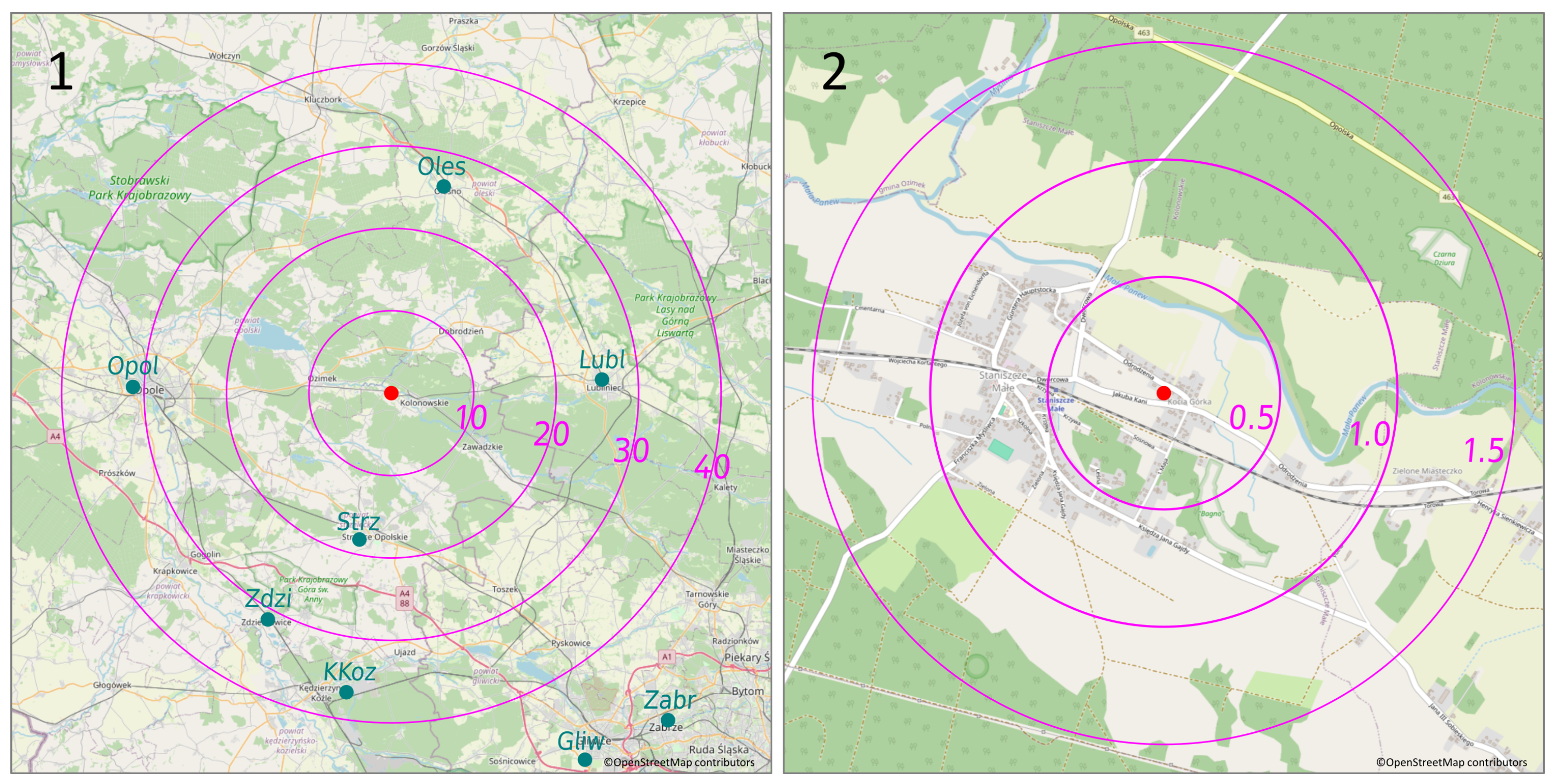






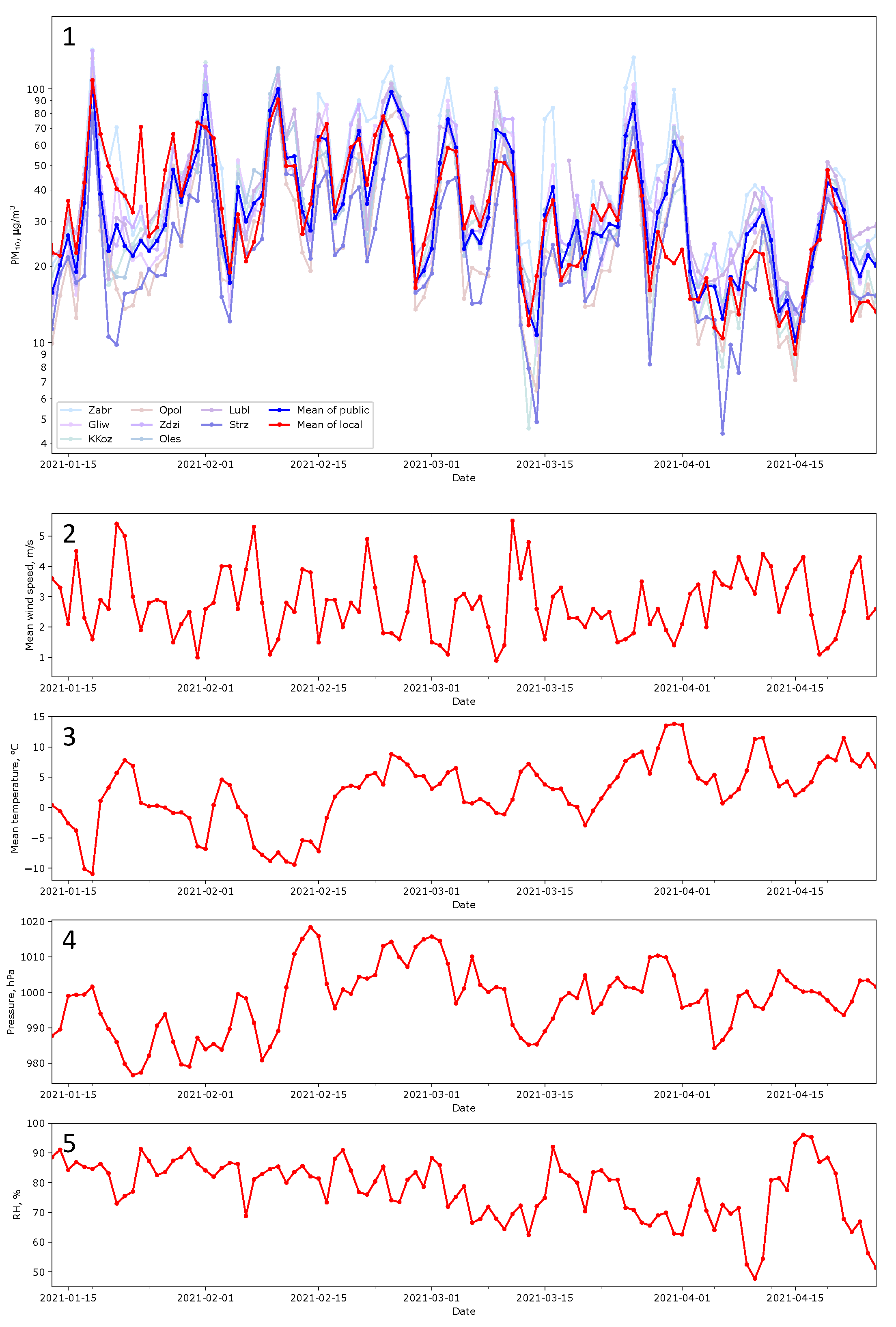
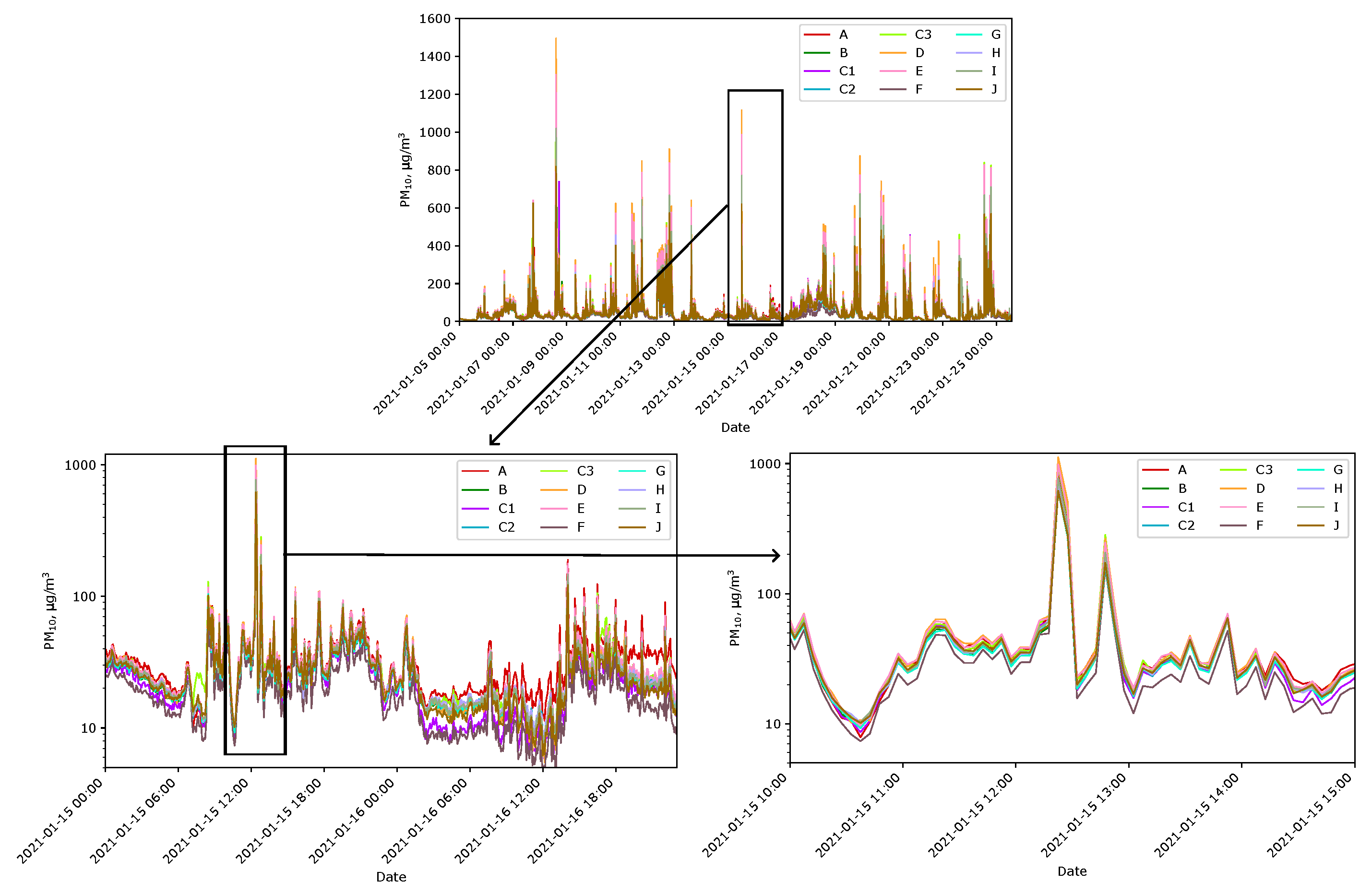



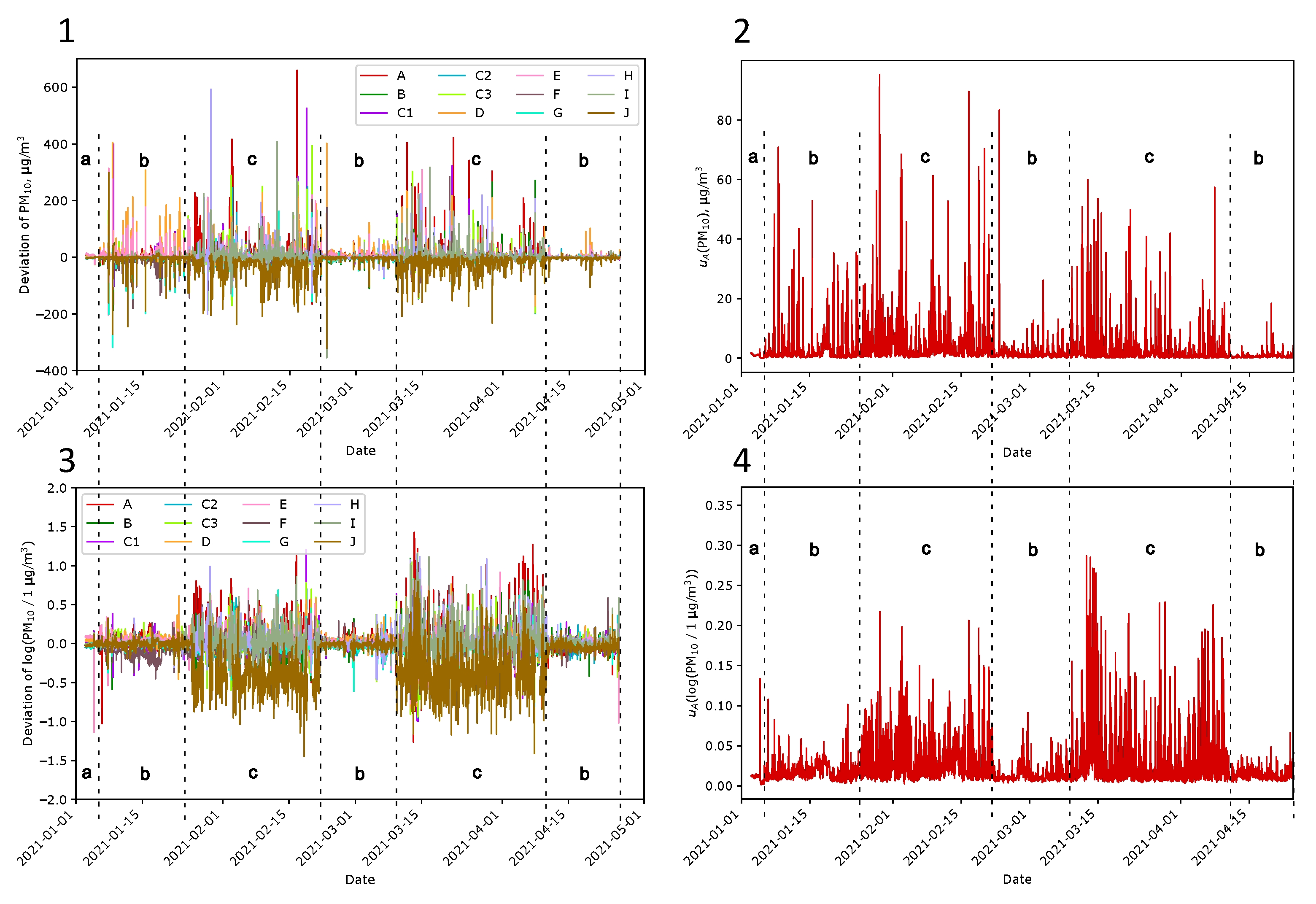



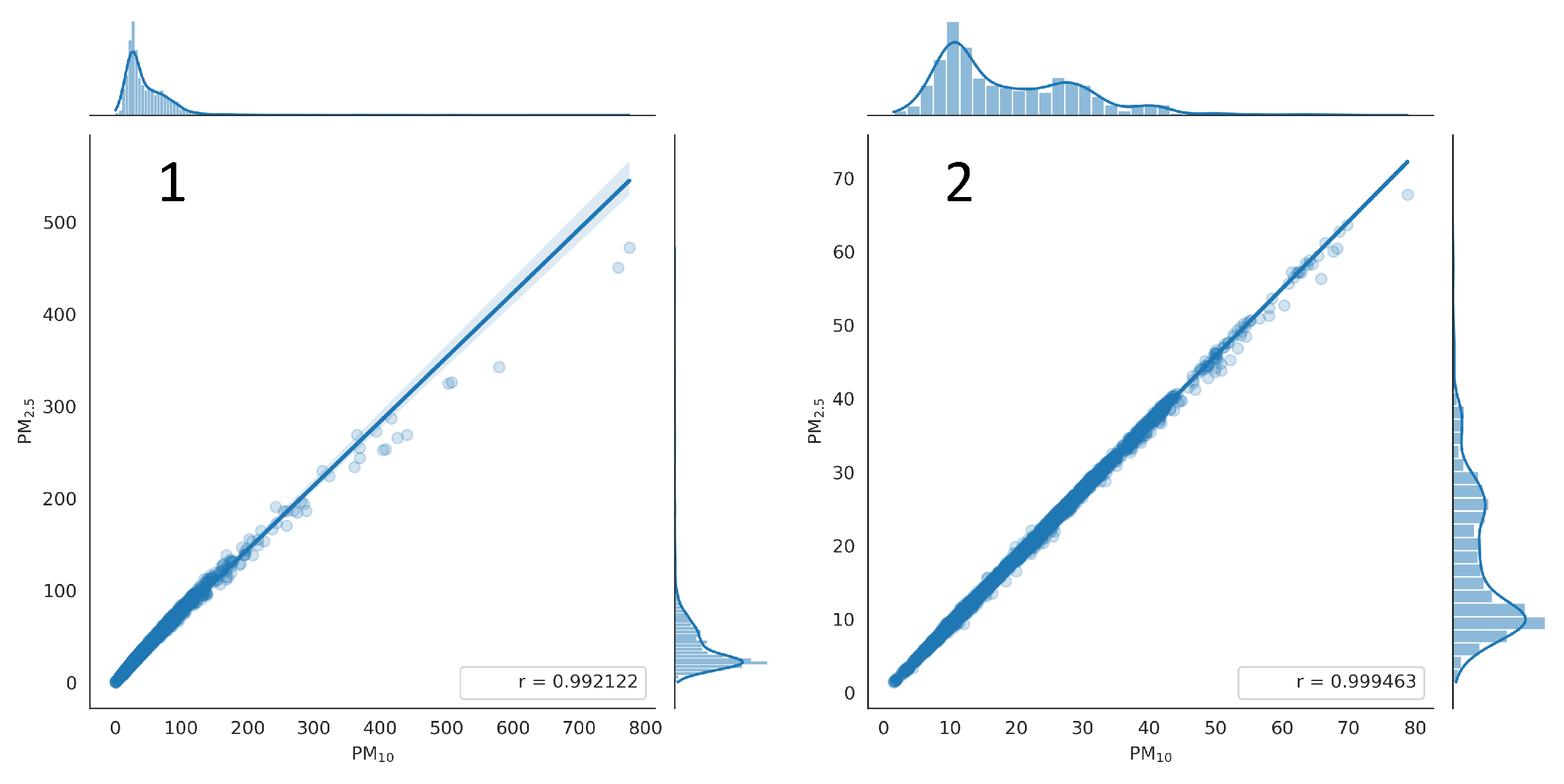

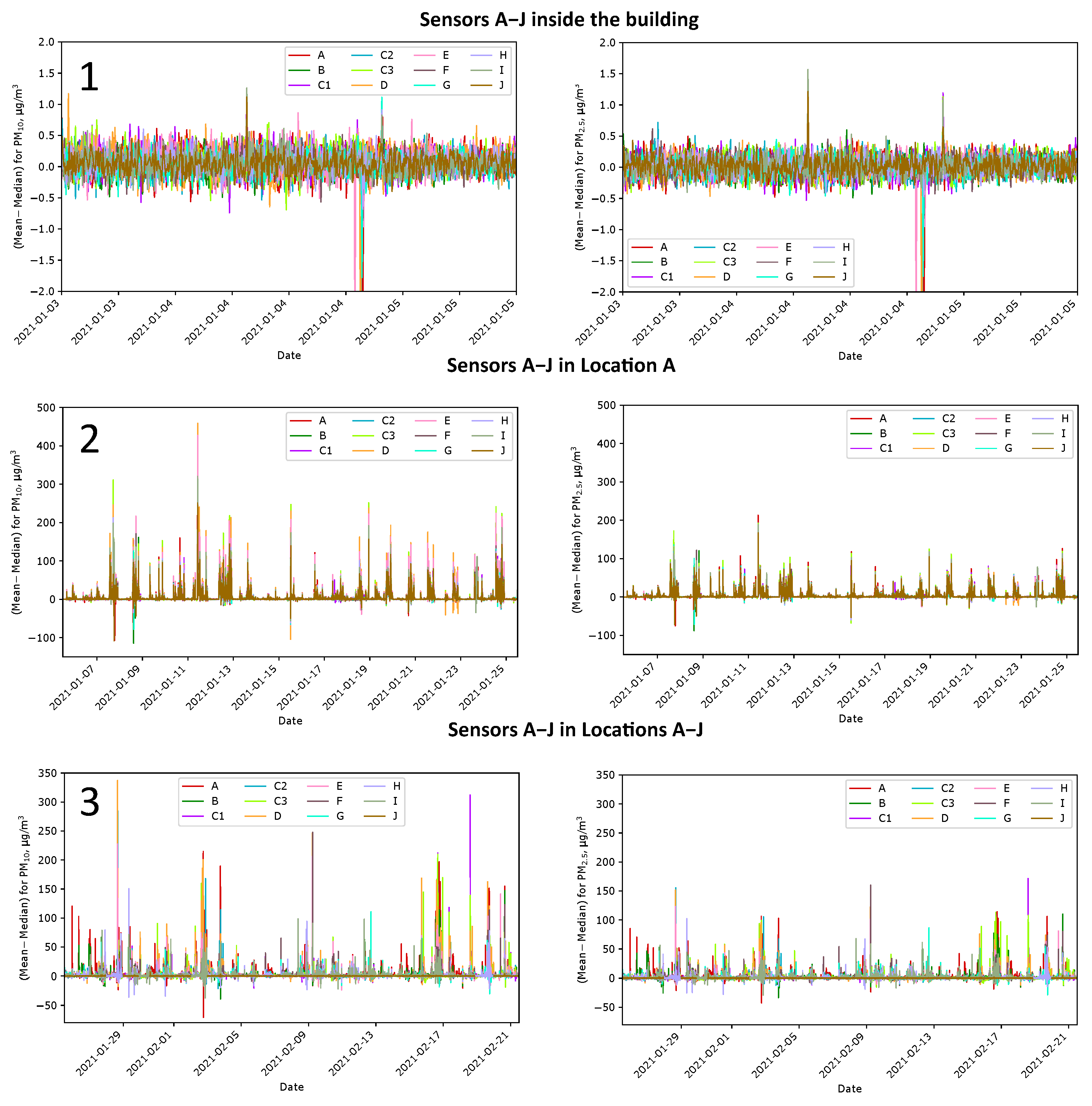
| # | Time Period | Condition | Description |
|---|---|---|---|
| 1. | 3 Jan 2021– 5 Jan 2021 | Condition a | Device tests, repeatability, gain |
| 2. | 5 Jan 2021–25 Jan 2021 | Condition b | Outdoor tests at one Location A |
| 3. | 25 Jan 2021–21 Feb 2021 | Condition c | Outdoor tests at Locations A–J |
| 4. | 21 Feb 2021–9 Mar 2021 | Condition b | — |
| 5. | 9 Mar 2021–10 Apr 2021 | Condition c | — |
| 6. | 10 Apr 2021–25 Apr 2021 | Condition b | — |
| # | Description | ||
|---|---|---|---|
| 1. | a—indoor | 0.84 | 0.010 |
| 2. | b—at one spot | 2.1 | 0.016 |
| 3. | c—spread | 3.4 | 0.027 |
| 4. | b—at one spot | 1.2 | 0.013 |
| 5. | c—spread | 1.7 | 0.029 |
| 6. | b—at one spot | 0.58 | 0.013 |
Disclaimer/Publisher’s Note: The statements, opinions and data contained in all publications are solely those of the individual author(s) and contributor(s) and not of MDPI and/or the editor(s). MDPI and/or the editor(s) disclaim responsibility for any injury to people or property resulting from any ideas, methods, instructions or products referred to in the content. |
© 2024 by the authors. Licensee MDPI, Basel, Switzerland. This article is an open access article distributed under the terms and conditions of the Creative Commons Attribution (CC BY) license (https://creativecommons.org/licenses/by/4.0/).
Share and Cite
Wiora, A.; Wiora, J.; Kasprzyk, J. Indication Variability of the Particulate Matter Sensors Dependent on Their Location. Sensors 2024, 24, 1683. https://doi.org/10.3390/s24051683
Wiora A, Wiora J, Kasprzyk J. Indication Variability of the Particulate Matter Sensors Dependent on Their Location. Sensors. 2024; 24(5):1683. https://doi.org/10.3390/s24051683
Chicago/Turabian StyleWiora, Alicja, Józef Wiora, and Jerzy Kasprzyk. 2024. "Indication Variability of the Particulate Matter Sensors Dependent on Their Location" Sensors 24, no. 5: 1683. https://doi.org/10.3390/s24051683
APA StyleWiora, A., Wiora, J., & Kasprzyk, J. (2024). Indication Variability of the Particulate Matter Sensors Dependent on Their Location. Sensors, 24(5), 1683. https://doi.org/10.3390/s24051683








